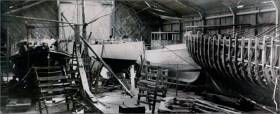Displaying items by tag: Tyrrell
Tyrrell Pilot Cutter Brings Added Maritime Heritage
The long-lived boatbuilding name of Tyrrell of Arklow carries a resonance far beyond the shores of Ireland writes W M Nixon. In its impressive history, the dominant figure was Jack Tyrrell himself, whose own experiences of seafaring infused all the vessels he created, particularly those he also designed.
“Sea-kindly” would be a description which would spring readily to mind. But Jack Tyrrell well knew that merely creating a boat which was comfortable at sea was not enough – somehow he had to provide his customers with boats which were both sea kindly and yet efficient to run, with a good turn of speed when required.
Thus he acquired a formidable reputation for easily-driven hulls which could keep the sea in all weathers, and for a long period in the middle of the 20th century, Tyrrell of Arklow pilot cutters defined the type. And just as the sailing pilot cutters of former years proved themselves ideal for conversion to no-nonsense cruising yachts, so the fully-powered Tyrrell pilot boats gave themselves readily to conversion into seaworthy motor-cruisers of character when their working days were done.
This 45-footer is a classic example for sale on Afloat.ie boats for sale dept with Crosshaven Boatyard. And it speaks volumes for the Tyrrell reputation that she has spent all her life in Cork Harbour. In other words, she was built in 1971 to be the Cork Pilot, and as soon as word went out that she was to retire upwards of 20 years ago, she was snapped up by a discerning local enthusiast who set about turning her into the dream motorcruiser.
This is a vessel for the dedicated owner. Her price of €29,950 reflects this, as it’s effectively a deposit, while the ongoing payment system is to be found in giving more attention to the maintenance than would be required with a modern glassfibre vessel which would initially cost several mutliples more. Yet thanks to this special vessel, we are able to run this historic photo of the Tyrrell yard in Arklow at its busiest in the 1960s, and I’m virtually certain that’s the Robert Clark-designed Gipsy Moth III nearing completion at the centre of the photo. Six years later, this Cork pilot boat went forth from the same place – details here.
Cargoship Gets into Scrap in Wicklow
The cargoship Arklow Rebel (2,999 gross tonnes) which loaded scrap metal in Wicklow Port today, is believed to be the largest Arklow Shipping Ltd vessel to dock in the east coast port, writes Jehan Ashmore.
The 7-year old Dutch-built vessel arrived in ballast from Warrenpoint Co. Down around 01.30hrs to berth alongside the town's south quays at the Packet Quay.
Throughout this afternoon there was a steady stream of lorries laden with the scrap-metal which was loaded into the ship's hull by a quayside grabber. Upon completion of loading, the distinctive green hulled Arklow Rebel departed this evening bound for Liverpool.
She is one of nine 'R'class series of ships built by the Dutch shipyard of Barkmeijer Stroobos B.V. and has the following dimensions (90m length X 12m breath X 4m draft). For further vessel characteristics click HERE.
The Irish-flagged vessel is registered at the neighbouring port of Arklow to the south and is part of a fleet of over 40 ships managed by the Tyrrell family.
During the boom years Wicklow port was particularly busy with Scandinavian imports of bundled packaged timber and plasterboard for the construction industry.
The tidal port at the mouth of the River Leitrim also specialises in paper, lead, steel and dry bulk cargoes, principally coal in addition to other general and heavy-lift project cargoes.
For many years the issue of road traffic congestion was finally solved when the Wicklow Port Access and Town Relief Road Scheme was completed in April of last year.
The port access road (1.6km) runs between the Rathnew Road to The Murrough via a bridge that crosses the Broadlough Estuary and over the Dublin-Rosslare railway line.
- Wicklow
- Arklow Shipping Ltd
- Wicklow harbour
- Liverpool
- ASL
- Wicklow Port
- Port of Wicklow
- Wicklow Port Access and Town Relief Scheme
- Arklow Rebel
- Tyrrell
- ScrapMetal
- Port and Shipping News
- Packet Quay Wicklow
- Wicklow Port Company
- Broadlough Estuary
- River Leitrim
- The Murrough
- DublinRosslare railway line
- Barkmeijer Stoobos B.V.

























































